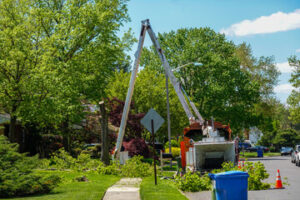Tree Service Fayetteville NC provides many services, including pruning, removal, emergency response, and maintenance. Look for companies that are members of a reputable industry association. They’ll be more familiar with best practices, like not topping trees (a practice that damages and weakens them).
Ask the company to provide proof of insurance. This includes liability insurance and workers’ compensation.

Tree service companies offer pruning services to keep trees healthy and beautiful. They can remove diseased or dead branches, shape the tree’s crown to improve its appearance and safety, and help with landscaping projects. They can also prune and trim shrubs and hedges. They may also remove stumps and grind them down to a safe level. Tree service companies are experts at working in built environments, where they can manage the size of woody plants and minimize hazards from overhead power lines and fallen debris.
When choosing a tree service, finding one with extensive training is important. A certified arborist can identify the needs of your landscape and advise you on the best course of action for pruning or removal. They can help you avoid costly mistakes, such as “topping” a tree, which is when the top branches are cut off, leaving the plant vulnerable to disease and stress.
Many tree services also offer emergency response to address storm damage to trees. They work around the clock to restore properties, removing damaged trees and assessing potential hazards. They can also help you with planting new trees, which requires a lot of knowledge and experience to ensure they grow properly and are planted in the right place. They can recommend the right species of trees for your property, taking into consideration soil conditions and space availability.
Removal
Tree removal is a complex job that should only be performed by a qualified professional. A good tree service will also treat any diseased trees to prevent further damage. They may use growth compounds or other treatments to improve the quality of the soil, and they will remove fungus from the roots. This will make the trees healthier and more attractive. They will also clean up the leaves and branches, which can be a fire hazard and promote unwanted insect infestations.
They offer a variety of services for residential and commercial properties. Their services include trimming and pruning, stump grinding, and yard cleanups. They can also provide emergency services for storm damage cleanup. They can even remove a tree that is leaning or damaged by wind or ice. They can also install new trees and shrubs and help you choose the right species for your property.
If you are a homeowner in the Staten Island area, you can call on this company for tree removal and stump grinding. Their crews are equipped with advanced machinery and can remove dead or dying limbs from your trees. They can also remove the stumps that are causing trips and falls in your yard.
The company offers a free estimate and accepts cash or personal checks as payment. It is a locally owned and operated business that serves the five boroughs of New York City. Its tree care specialists can handle large and small jobs, and it provides 24-hour emergency tree services.
Emergency Response
When trees become a threat to people or property, they need to be removed promptly. This includes situations such as a tree that has fallen onto a home or car, or if it is leaning precariously against a house. It also includes tree limbs that are hanging dangerously close to power lines. In these cases, it is best to call the local utility company (the people whose name is on your electric bill). They can let you know if the tree or limbs are in contact with electricity and whether it is safe for crews to work on it.
In some cases, a tree’s condition may worsen rapidly and require emergency intervention. This could be due to severe weather conditions, an insect infestation, or a disease that is progressing quickly. Having a reputable tree service on speed dial is essential to protecting your property and preserving its value.
When choosing a tree service, look for teams that are certified arborists and have extensive experience with emergency response. In addition, they should be insured and have a good reputation for customer satisfaction. This will ensure that they are able to respond quickly and efficiently when you need them most. To avoid any mishaps during the removal process, they should also use safety precautions like cordoning off the area and using cranes or bucket trucks for hard-to-reach areas.
Maintenance
Trees require proper maintenance to ensure the health of both the trees and the surrounding property. Tree trimming, pruning, stump grinding, and planting are some of the services offered by tree service providers. These professionals can also assist in the removal of invasive species and dangerous branches. They can also offer advice on how to improve the landscape of a property with proper planting and mulching.
When hiring a tree service, it’s important to check out their reputation. A good company should have positive reviews on multiple platforms. Moreover, they should have accreditation from the Better Business Bureau. It’s also important to find out how long they have been in the industry.
Using a tree service can help homeowners reduce the risk of falling limbs or entire trees due to storms or high winds. Arborists will inspect trees for damage or structural faults and help owners plan accordingly. A tree service can also help identify pest infestation and other problems before they escalate to a serious problem.
The team of professionals at Queens Tree Service offers residential tree-related services for property owners in New York City. They prune and trim trees to prevent them from hitting power lines, light posts, and sidewalks. They can also remove dead and obstructive trees and clear the area of debris and roots. They also offer stump grinding services and recycle wood chips, byproducts, and other materials to the community.


